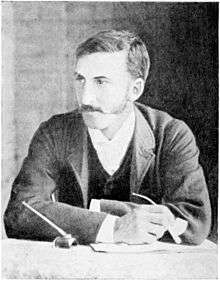Barcroft Boake
Barcroft Henry Thomas Boake (26 March 1866 – 2 May 1892) was an Australian poet.
Barcroft Boake | |
|---|---|
 Portrait of Australian poet Barcroft Boake | |
| Born | Barcroft Henry Thomas Boake 26 March 1866 Balmain, New South Wales |
| Died | 2 May 1892 (aged 26) Long Bay, North Sydney, New South Wales |
| Language | English |
| Nationality | Australian |
| Genre | bush poetry |
| Notable works | "Where the Dead Men Lie" |
| Years active | 1890–1892 |
Background
Born in Sydney, Boake worked as a surveyor and a boundary rider, but is best remembered for his poetry, a volume of which was published five years after his death.
Boake was eldest son of Barcroft Capel Boake (b. Dublin, 1838) and his wife Florence Eva, née Clarke (1846–1879).
In July 1886 Boake joined E. Commins, a surveyor, and had experience as a field-assistant, working for some time in the Monaro (New South Wales). After spending two years in the surveying camp Boake was disinclined to return to the city, took service as a boundary rider, and worked in New South Wales and Queensland. In May 1890 Boake joined W. A. Lipscomb, a surveyor, and remained with him until the end of 1891. About this time he began to send verses to The Bulletin, which were published.
His poems were all published posthumously in 1897 by A.G. Stephens in a collection titled "Where the Dead Men Lie: and Other Poems". "Where the Dead Men Lie" was the most famous of his poems, which described the tragedies Australians faced during the 1891–93 depression. Scottish-Australian poet and bush balladeer Will H. Ogilvie (1869–1963) penned The land of dumb despair (1898) in memoriam to Boake.
Boake is believed to have committed suicide. His body was found hanging by the neck from a stockwhip at Long Bay, North Sydney eight days after he disappeared on 2 May 1892.[1] One writer on Boake's life has mentioned that the suicide took place during the 1891–93 depression when the poet was unable to find work, also noting that "it has been suggested that he killed himself for the love of one of the McKeahnie girls," sisters of the horseman Charlie McKeahnie.[2]
Notes
- "A Ghastly Discovery". Australian Star (Sydney, NSW : 1887–1909). 14 May 1892. p. 11. Retrieved 18 April 2019.
- Hugh Capel. "Maybe This is the Snowy Horseman," Canberra Times, 25 February 2002
Bibliography
- Barcroft Boake. Where the Dead Men Lie, and Other Poems 1897
Individual poems
- "Jack's Last Muster" (1890)
- "Where the Dead Men Lie" (1891)
References
- Hugh Capel. "Tragic End for a Bush Poet," The Canberra Times, 27 March 2002
- Serle, Percival (1949). "Boake, Barcroft". Dictionary of Australian Biography. Sydney: Angus and Robertson. Retrieved 6 July 2009.
- Cecil Hadgraft, 'Boake, Barcroft Henry Thomas (1866–1892)', Australian Dictionary of Biography, Volume 3, MUP, 1969, pp 186–187.
External links
- Barcroft Henry Boake at Boake.net
- Barcroft Boake (1866–1892) at Middlemiss.org
- Boake.info | Boake Family Genealogy
- Works by or about Barcroft Boake at Internet Archive
- Works by Barcroft Boake at LibriVox (public domain audiobooks)
